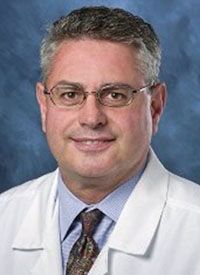Article
Molecular Testing Essential in NSCLC Management
Author(s):
Jean Lopategui, MD, reflects on the use of molecular testing for patients with non–small cell lung cancer.
Jean Lopategui, MD, associate professor of pathology and director of Molecular Genetics Pathology Fellowship at Cedars-Sinai

Jean Lopategui, MD,
Assessing for molecular abnormalities is an essential component in the diagnosis and management of patients with non—small cell lung cancer (NSCLC), explained Jean Lopategui, MD.
Moreover, with the use of next-generation sequencing (NGS) to identify molecular abnormalities in a patient’s tumor, a number of targeted therapies may be available, Lopategui said. Furthermore, future targeted drug developments could eventually complement or delay the need for chemotherapy in the treatment of patients with lung cancer.
“Lung cancer, especially NSCLC, is the poster child for molecular testing. The number of tests that are available to define and predict response to treatment is very high in NSCLC. We used to do several tests in the past to categorize each of the genes and their mutations, which was time-consuming and expensive,” said Lopategui, associate professor of pathology and director of Translational Genomics and of the Molecular Genetics Pathology Fellowship at Cedars-Sinai. “Today, we have NGS that allows us to test multiple genes and multiple mutations in one test.”
In an interview during the 2020 OncLive® State of the Science Summit™ on Lung Cancer, Lopategui reflected on the use of molecular testing for patients with NSCLC.
OncLive: How can genomic sequencing be used to determine what agent patients with NSCLC should receive upfront?
Lopategui: Many drugs have been FDA approved that are specifically targeted at specific genetic sensitivity mutations, such as EGFR, BRAF, ALK, ROS1, and NTRK; they are highly efficient in NSCLC. They are also becoming first-line treatments in some cases, especially for EGFR, instead of chemotherapy. That is a big advantage compared with prior years, where chemotherapy was the only available agent. Now, we have [identified these] mutations that can be [treated with these targeted agents. Other drugs are in development and are being explored in clinical trials. They are designed at emerging targets including MET exon 14 skipping mutation or amplification, RET fusions, HER2 mutation, and tumor mutational burden.
There are agents for NTRK fusions that have been recently been approved by the FDA; this is not specific to lung cancer and NTRK fusions are a pan-cancer maker. Those are big advances, although they are rare in lung cancer with less than 1% [of patients affected]. While rare, if a patient carries that mutation, there is an option to treat them with an NTRK inhibitor.
How has the use of genomic sequencing in NSCLC evolved over the years?
It has evolved at the speed of light. Ten years ago, there were not many targeted therapies so there has been a tremendous improvement in the treatment of patients with NSCLC.
In patients with stage IV NSCLC about 50% succumbed to the disease within a year. Today, there are remissions in most patients who carry genetic mutations. [This is because these mutations] are targetable and druggable. Some patients live 3 or 4 years, and there are some instances of survival for over 10 years.
This is complemented by immune checkpoint inhibitors, which are coming as a second-line treatment option after disease progression on targeted therapies or chemotherapy. In EGFR and ALK-negative patients, they are considered [for single-agent frontline immunotherapy if they are expressing PD-L1], or MSI-H at progression following prior treatment. That further extends the lives of patients with NSCLC and is a tremendous improvement to where we now have therapies that are highly effective. Unfortunately, these are not leading to cures. Patients do relapse, but there are incremental progresses that are significant in terms of years and not just months.
How are liquid biopsies being used in lung cancer?
Liquid biopsies are still an emerging technology. They are often used instead of tissue biopsies because it is easier, and tissue is not necessarily readily available. However, the 2020 National Comprehensive Cancer Network guidelines stated that liquid biopsies should only be used in the case when the patient is medically unfit for an invasive tissue sampling or when there is insufficient material for molecular analysis if a follow-up tissue-based analysis is planned for all patients in which an oncogenic driver is not identified. This is because there are many false-negative results plasma-based circulating tumor (ct)DNA and detection requires a very high sensitivity. The number of ctDNA copies is not always high and therefore, the false-negative rate with liquid biopsies can be up to 30%.
What other roles could ctDNA have during a patient’s disease course?
There are several studies showing that ctDNA is helpful as a monitoring tool after a mutation has been established, or to detect the early emergence of resistant mutations before clinical resistance develops. This allows for early adjustment of therapy.
It is also used to monitor [ctDNA mutation frequencies before and after surgery]. The latter has been shown to be a predictor of relapse if ctDNA is identified after surgery. However, ctDNA may be performed at diagnosis because of lack or delayed access to tissue formalin fixed paraffin embedded blocks, delayed turn around time, and need to implement therapy promptly. In this instance, if ctDNA is negative, follow-up with tissue testing is indicated. Some advocate to do both, tissue and plasma testing as several studies have shown an increased rate of detection of mutations.






%20(2)%201-Recovered-Recovered-Recovered-Recovered-Recovered.jpg?fit=crop&auto=format)

%20(2)%201-Recovered-Recovered-Recovered-Recovered-Recovered.jpg?fit=crop&auto=format)
%20(2)%201-Recovered-Recovered-Recovered-Recovered-Recovered.jpg?fit=crop&auto=format)